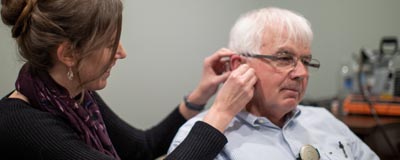A Hearing Story with Rob Meagher:
This is the second post of our two part blog series speaking with Davidson Hearing Aid Centres’ own Rob Meagher. If you haven’t read the first part yet, please click here to read it first. Rob is a Hearing Instrument Practitioner with over 35 years of experience, who has struggled with hearing loss his entire life and has worn hearing aids since the age of five. When Rob realized his hearing was getting worse and he was struggling to hear his customers, he decided to take the next step in his hearing journey by getting a cochlear implant. Rob shares the story of his journey and how cochlear implants continue to have a positive impact on his life.

If you’ve struggled with hearing loss, you know how frustrating it can be. Here at Davidson Hearing Aid Centres, we’ve helped thousands of patients hear better over the past 80 years. We are here to tell you that there is hope, whether it is through hearing aids, adding an accessory of an FM system, or possibly getting a cochlear implant.
This is the Part II of our blog series talking with Rob about his cochlear implant journey. If you haven’t read the previous one, please click here to read Part I first.
Rob’s Cochlear Implant Success Story
About 12 years ago, Rob got his cochlear implant. He says that he missed hearing simple sounds before getting the cochlear implant, like the turn signal in the car. He notes that even with his hearing aids cranked up to full power, he wasn’t able to hear certain sounds.
“We amplify the sound so that you to be able to hear them, but the brain still has to do the final processing. In severe hearing loss cases where the hair cell receptors deteriorate, the clarity of the sounds gets destroyed. So in other words, even with amplification, people can have trouble distinguishing between the sound that they receive and what they actually want to hear,” Rob explains.
When Rob first got the cochlear implant turned on, the first thing he noticed was that he could hear the turn signal in the car. “Speech clarity was okay, but it was just so digitized. I always explain it as sounding like Darth Vader in Star Wars. But the clarity was so much better than what I experienced. I could actually maybe close my eyes and be able to understand you.” This change in sound quality is mentioned by most cochlear implant users. With common descriptions being robotic, cartoonish, or sounding like Mickey Mouse.
Initially after getting his cochlear implant, Rob wasn’t hearing certain sounds, like “S.” With therapy, he’s now able to hear much better. He also notes that his speech has improved quite a bit. He’s heard a lot of comments from others about how much getting the cochlear implant and going through speech therapy have improved his speech.
Like many adults with a cochlear implant, Rob has only had one ear implanted and continutes to wear a hearing aid on the other side. This is referred to as a bimodal fitting. Although he does not hear as well from the hearing aid side, it provides better access to some of the bass sounds and for Rob, it improves the comfort and quality of the sounds overall.
Rob estimates that with his hearing aid and the cochlear implant, his hearing is at 50 percent. However, that’s actually a lot better than it used to be. He says of his experience post-cochlear implant, “It’s much easier to go to work every day and communicate with people on a daily basis. The improvement in clarity was just amazing. It did take a while to get used to the sound quality though.”
While having the cochlear implant has allowed Rob to relax and be able to communicate with people more effectively, he notes that group situations are still difficult to navigate.
Rob’s first cochlear implant lasted a year and a half, and then he needed a new one installed. That’s when he really noticed a difference. “Since I had the new one installed, words are certainly much clearer. I remember saying to my wife, ‘What’s that sound that I’m hearing?’ It might have been the microwave or stove beeping. Traditionally, I would never have heard it. I used to go make a coffee or something like that, and the bell would go off. My wife would have to tell me that it went off and the coffee was ready.”
Rob sums up his experience with cochlear implants by saying, “It definitely improved my life overall. If somebody were to come in and ask me if they should do it, I’d probably say if the properly fit hearing aids aren’t doing the job, then it’s time to consider a cochlear implant.”
How Do You Know When It’s Time to Get a Cochlear Implant?
Getting a cochlear implant wasn’t a decision that Rob made lightly. He did quite well with hearing aids for a long time. Ultimately, Rob trusted his gut. He considered a cochlear implant in his 40s but knew he wasn’t ready. Ten years later, as he began struggling to hear clients at work, he knew it was time.
Rob shares this advice with his customers: “I say, just go get assessed. If you’ve done everything you can and you’re still not hearing well, it’s time to talk to your audiologist and see if they recommend cochlear implants.”
Getting cochlear implants is a fairly routine procedure, but like any surgery, it does carry some risks. Here are some additional considerations:
- Cochlear implants won’t fully restore hearing
- Like hearing aids, cochlear implants require ongoing maintenance
- Getting used to cochlear implants takes time and therapy, and it can be frustrating at first
But for people with severe hearing loss, the pros often outweigh the downsides:
- Cochlear implants can help you better communicate with the outside world
- You may be able to hear sounds you’ve never heard before
- The outcomes typically improve steadily for the first 6-12 months
- Cochlear implants can open new learning and career opportunities
What Is the Process for Getting a Cochlear Implant?
While we don’t offer cochlear implants directly at Davidson Hearing Aid Centres, we have a fantastic working relationship with the Ottawa Hospital and can make referrals directly to them. The majority of cochlear implant recipients are fit in a bimodal fashion where they continue to wear a hearing aid on one side with the cochlear implant on the other. For these clients, we continue to provide and service the hearing aid part of that equation. We also help with specialty earmolds that may be required.
If we believe that a patient is a good candidate for a cochlear implant, we refer them to the cochlear implant team at the Ottawa Hospital for an assessment. If they are deemed to be a fit for the implant and want to proceed with the process, there is usually a 12-18-month wait time for surgery. One to two months after surgery, the cochlear implant is activated and programmed by the audiologist at the Ottawa Hospital.
And as far as cost goes, in Ontario the cochlear implant surgery and first device are funded through OHIP. For subsequent devices, the governments Assitive Devices Program provides assistance.
Ready to Experience a New World of Sound?
Here at Davidson Hearing Aid Centres, seeing the exhaustion and challenges faced by individuals with hearing limitations inspires our commitment to support them throughout their journey. Our goal is to empower individuals to make informed decisions about their hearing health so they can regain the joy and ease of communication they truly deserve.
If you or a loved one is experiencing hearing loss, our team of hearing professionals is here to support you. If you’d like to schedule an appointment to discuss your options, please feel free to call us at (613) 233-3149 or request a callback.






